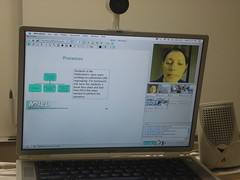Time Magazine – How To Bring Our Schools Out of the 20th Century
by Claudia Wallis and Sonja Steptoe
You’ve probably already read this article (and if you haven’t you should – here’s the link), or have read about this article (like here, here or here), but I like this article enough to comment about it (maybe more than once).
Early on Wallis and Steptoe make the following statement:
“This is a story about the big public conversation the nation is NOT having about education, the one that will ultimately determine not merely whether some fraction of our children get “left behind” but also whether an entire generation of kids will fail to make the grade in the global economy because they can’t think their way through abstract problems, work in teams, distinguish good information from bad or speak a language other than English.”
In our rush to “improve” schools, we have made a common error – one we should know better than to repeat. That error is only focusing on what is perceived as wrong with schools without taking note of what schools have done that has contributed to our economy and our ability to invent and innovate. I’m not sure we really understand what has led us to be a powerhouse in that department – definitely something to do with our freedoms, free markets, our higher education, and lots of conjecture – but do we really know all the parts of the puzzle? What have we cut from our children’s school experience in our race to “improve” that might be an important cog in that wheel? Music? Art? … you know the list. And, what have we failed to include that is new or missing that will keep us competitive?
We have spent an enormous amount of time “implementing” and debating the good and the bad of NCLB, and one of the downsides of that has been little time to even think about having the conversation described in the quote above.
To those of us who are passionate about “Building a student for the 21st century” this quote is old news. But I think because we have the conversation often and are drawn to ANY news about 21st century education we think it is old news when really (and unfortunately) it is not. I’m encouraged that this article at least brings more credence to the debate. Not that I think Time magazine is the last word by any means, but it is not “Edutopia”or “Wired” or someone’s edtech blog or an online edtech magazine. The edtech gurus who travel around too often forget that if someone is attending a conference where they are presenting they are a different audience than a typical classroom teacher or administrator – because believe me, as a classroom teacher and workshop presenter, MOST teachers and administrators don’t even know what the quote is referencing. I’m taking an online class right now with 5 other teachers from my school – one of the requirements of the class is to write and respond on the class blog. None – not one of the other teachers taking the class with me had ever heard of a blog before they took this class.
Having said that however I am seeing a significant awareness in education that the boat is leaving the dock and we don’t have tickets. Even when I compare this school year over last year – I have experienced a longing by educators to embrace new approaches and tools – and I am enthusiastic about the possibilities.
Here’s hoping that learning and thinking about learning gets messy.


